Alamgir Miah1, M. M. H. Miah1, Masud Kamal2, M. I. Chowdhury2, M. Rahmatullah3
1Department of Physics, University of Chittagong, Bangladesh
2Radioactivity Testing and Monitoring Laboratory, BAEC, Chittagong, Bangladesh
3Department of Community Medicine, Delta Medical College, Mirpur, Dhaka, Bangladesh
Correspondence to: M. M. H. Miah, Department of Physics, University of Chittagong, Bangladesh.
| Email: |  |
Copyright © 2012 Scientific & Academic Publishing. All Rights Reserved.
Abstract
The activity concentrations of naturally occurring radionuclides 226Ra, 232Th and 40K, were measured by using a Broad Energy Ge (BEGe) detector for soil samples collected from the Malnichara tea garden in Sylhet district of Bangladesh. The average activity concentrations of 226Ra, 232Th and 40K in soil samples were found to be 55.284±4.68, 125.270±5.81 and 497.91±43.83 Bqkg-1, respectively. The results obtained for the corresponding nuclides are slightly higher than the worldwide average values of 35, 30, and 400 Bqkg-1, respectively. The average outdoor absorbed dose and the annual effective dose rates due to 226Ra, 232Th and 40K were observed to be 124.12 ± 7.59 nGyh-1 and 152.22±9.31 µSvy-1, respectively; which are above the world average. Whereas, the radium equivalent activity and external hazard indices are less than the world average values.
Keywords:
Activity Concentration, Absorbed Dose, Effective Dose , World Average Values
Cite this paper:
Alamgir Miah, M. M. H. Miah, Masud Kamal, M. I. Chowdhury, M. Rahmatullah, "Natural Radioactivity and Associated Dose Rates in Soil Samples of Malnichera Tea Garden in Sylhet District of Bangladesh", Journal of Nuclear and Particle Physics, Vol. 2 No. 6, 2012, pp. 147-152. doi: 10.5923/j.jnpp.20120206.03.
1. Introduction
The natural radioactivity in the environment is the main source of radiation exposure for human body. Natural radionuclide in soil contributes a significant amount of background radiation exposure to the population through inhalation and ingestion. The main contributors of radionuclides are 226Ra, 232Th and 40K. Since these radionuclides in soils are not uniformly distributed and vary from region to region (1,2).. Therefore the knowledge of their distribution in soil and rock play an important role in radiation protection and measurement (3, 4). The radioactivity concentration of these nuclides above permissible level is very harmful to the human body. Therefore, measurements of natural radioactivity in soils and the radiation doses are of great interest to the researchers which have led the nationwide surveys throughout the world (5,6). . There have been many surveys to determine the background levels of radionuclides in soils which have been turned out to calculate the absorbed dose in air (4).The Sylhet district is a traditional tea growing area in Bangladesh. It has about 150 tea gardens, and nearly 300,000 workers are employed in the tea gardens. Bangladesh is earning a lot of foreign currencies by exporting tea in abroad.Tea is a one kind of popular soft drinks. About 70% of the people in Bangladesh drink tea for refreshment. The Sylhet area is very near to Assam and Tripura of India. Some Uranium deposits were found in those States of India. The aim of the present work is to search the possibility of uranium deposition as ore and health risk assessment associated with Thorium and Potassium in the study area. This work was undertaken to measure the activity concentrations and γ- ray absorbed doses of the naturally occurring radionuclides (238U, 232Th and 40K) in soil samples of Malnichera tea garden in Sylhet. Moreover, another aim of the present work is to create the public awareness about the radiation hazards and the workers those who are working in this tea garden .This study will also be helpful to establish a research base line in this area.
2. Methods and Materials
2.1. Study Area
Sylhet Division is the northeastern part of Bangladesh, named after its main city, Sylhet. It is bounded by Meghalaya State of India on the north, Tripura State on the south, Assam State of India on the east and Dhaka division on the west and Chittagong division on the southwest. The area around Sylhet is a traditional tea growing area. The Malnichera tea garden is situded in Sylhet sadar district which is nearly 3 Km northern side from the main Sylhet town. A map of Sylhet sadar and the location of this tea garden is shown in Fig. 1. 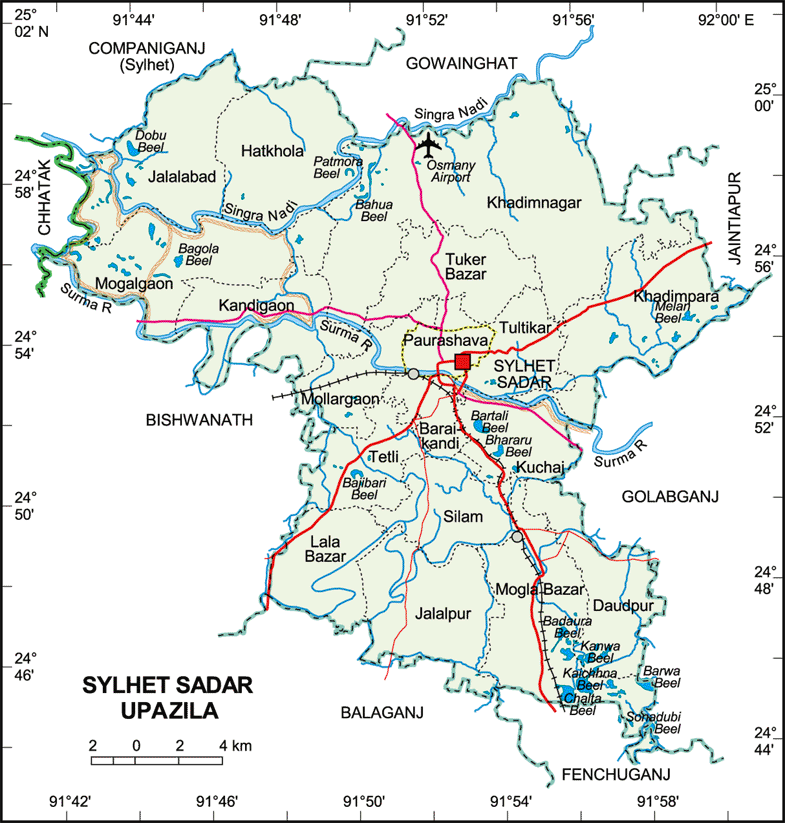 | Figure 1. Location map of Malnichera tea garden in Sylhet district of Bangladesh |
2.2. Sampling Locations
A total number of 7 soil samples were collected from the Malnichera tea garden in Sylhet. It is one of the largest tea garden in Bangladesh .All the soil samples were collected during the whole day of 8 March in 2010. The sampling stations are located by the geographical position of Latitude ranged over 2455.43′-2503.56′N and Longitude 9151.41′ - 9220.10′E.
2.3. Sample Collection and Preparation
Locations of 7 soil samples were chosen randomly from Malnichara tea garden in Sylhet. Each soil sample was collected from the surface and was marked by the number A1, A2, A3 …..etc.. After collection of samples, they were cleaned and dried into the sun and crushed into fine powder by using a mortar.The homogenized soil samples were then dried in an oven at 60 - 80℃ for about 24 hours and then weighted by an electrical balance. All the samples were packed into containers and then sealed tightly with an insulating tape around the opening of the containers for impeding the possibility of moisture contamination of air. In order to maintain radioactive equilibrium between 226Ra and its daughters, the packed PVC containers were stored for a period of 4 weeks.
2.4. Gamma-ray Detection System
In γ-ray spectrometry, the full energy peak efficiency of a high purity Germanium (HpGe) detector is the number of γ- rays detected by the detector to the number of photons emitted by the source for a specific energy, which is defined as (4)  | (1) |
where, n(E) is the net count rate of the photo peak for the corresponding energy E , A is the present activities of the standard reference source which were calculated by using the well known decay law: A = A0 e-λt. and Iγ is the Intensity of the gamma energy. For the determination of efficiency of the detector (HpGe), the contributions for the coincidence summing effect and the angular correlations due to the cascading gamma-rays were taken into account followed by the literatures (7,8). In the present study, the International Atomic Energy Agency (IAEA) reference samples were used for the calibration of detector efficiencies. The IAEA reference samples are: RGU-1, Uranium is in silica matrix, RGTh-1: Thorium is in silica matrix and RGK-1: potassium sulphate. The standard reference source has the same diameter as the soil samples of known concentrations of 238U, 232Th and 40K radionuclides supplied by the Canada Centre for Mineral and Energy Technology (CAMET) under a contract with the IAEA
2.5. Activity Concentrations of Soil Samples
The radioactivity of each sample was measured using the calibrated high purity Germanium (HpGe) Detector of energy resolution of 2 .0 KeV at 1.33 MeV of 60Co. for a period of 10,000 s. Keeping the samples one by one on the top of the detector and counted for a period of 10,000 s. The activity concentration (A) of each radionuclide in the sample was determined by using the net count rates (Nc) after subtracting the background counts from the gross counts for the same counting time under the selected photo peaks, weight of the sample, the photopeak efficiency and the gamma intensity at a specific energy as: | (2) |
Where, A = Activity concentration of the sample in Bq/.KgNet count rate, Nc = Gross counts per second from the samples - background counts per secondε = Efficiency of the detector for the specific energy.Iγ = Intensity of the gamma ray.W = Sample weight in gm.For the analysis of peak areas of gamma spectra, a Computer software programming (GENE 2000) was used.
2.6. Absorbed Dose Rates
The external outdoor absorbed gamma dose rates due to terrestrial γ- rays from the nuclides 226Ra, 232Th and 40K at 1 m above the ground level was calculated as (UNSCEAR 2000) (9)  | (3) |
Where, CK, CTh, CRa, are the average activity concentrations of 40K, 232Th and 226Ra. About 98% of the external γ dose rate from 238U series is delivered by the 226Ra sub series. So disequilibrium, between 226Ra and 238U will not affect the results of dose calculations from the measurement of 226Ra.
2.7. Annual Effective Dose Rates
The absorbed dose rate was converted into annual effective dose equivalent by using a conversion factor of 0.7 SvGy-1 recommended by the UNSCEAR(9) and 0.2 for the outdoor occupancy factor by considering that the people on the average, spent ∼ 20% of their time in outdoors (8). The Effective dose due to natural activity in the soil was calculated by:  | (4) |
2.8. Radium Equivalent Activity
Radionuclides of 226Ra, 232Th and 40K are not homogeneously distributed in soil. The inhomogeneous distribution from these naturally occurring radionuclides is due to disequilibrium between 226Ra and its decay products. For uniformity in exposure estimates, the radionuclide concentrations have been defined in terms of radium equivalent activity (Raeq) in Bq kg-1. This allows comparison of the specific activity of materials containing different amounts of 226Ra, 232Th and 40K according to Beretka and Mathew (10) as follows. | (5) |
Where, CRa, CTh and CK are the activity concentrations of 226Ra, 232Th and 40K in Bq kg-1, respectively.
2.9. External Hazard Index
The external hazard index (Hex) is the indoor radiation dose rate due to the external exposure to gamma radiation in construction materials of dwellings which was calculated by(11): | (6) |
Where, CRa, CTh and Ck are the specific activities of 226Ra, 232Th and 40K in Bq.kg-1, respectively. This index value must be less than unity to the radiation hazard insignificant i.e; the area is safe to the human for living.
2.10. The Ratio of 226R/228R
The ratio of 226R / 228R concentration activities is less than 1 because the concentration activity of 226Ra in soil is less than the concentration of 228Ra. In other word, the concentration of uranium in soil is less than thorium, since uranium and thorium are the parents of 226Ra and 228Ra, respectively. The range of this ratio is obtained 0.356- 0.586.
3. Results and Discussion
In the present study of soil samples at Malnichara tea garden in Sylhet district of Bangladesh, the results can be summarized as:i). Activity concentrations, and ii).Radiological indices.
3.1. Activity Concentrations in Soil Samples
Activity concentrations for nuclides 226Ra, 232Th, 40K and 137Cs in Malnichara tea garden soil samples were determined by equation (2) and the results for the same have been shown in Table 1 with the uncertainty of 1σ level. Here, the table shows that the highest value is found for sample 7A. The highest value of the nuclide may vary from place to place and this variation may be due to the chemical changes of the constituent elements of soils. Moreover, it is also possible due to the excess use of agricultural fertilizers and pesticides. All the associated errors were added in quadrature in order to obtain the total uncertainty. The results for the nuclides ( 226Ra, 232Th and 40K) are also shown independently through Fig. 2, 3 & 4, respectively.
3.2. 226Ra Activity
In soil samples, the activity concentrations of 226Ra were found in the range of 23.91±4.19 – 143.70±7.38 Bq/kg, with an average value of 55.25±4.68 Bq/kg. This result is higher than the worldwide average value of 35 Bq/kg (shown by the dotted line) for the same radionuclide in soils reported by UNSCEAR(9)
3.3. 232Th Activity
The activity concentration of 232T is found in the range of 53.25±4.80 – 369.60±10.52 Bq/kg with mean value 125.27± 5.81 Bq/kg .This result is also higher than the world average of 30 Bq/kg (9) (shown by the dotted line).Table 1. Activity concentrations (in Bq/kg) in soil samples
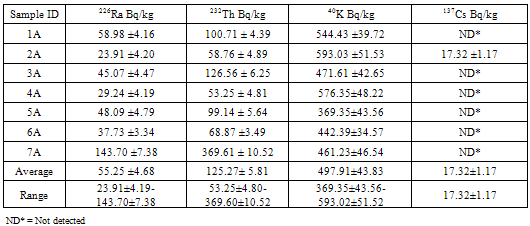 |
| |
|
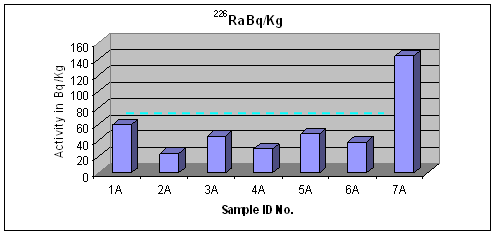 | Figure 2. Distribution of 226Ra in soil samples |
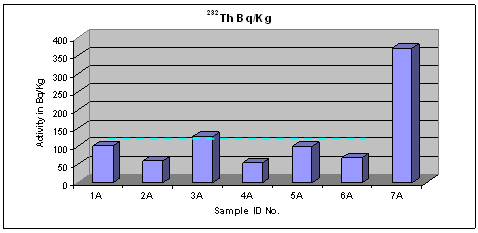 | Figure 3. Distribution of 232Th in soil samples |
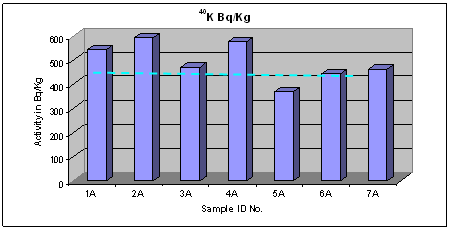 | Figure 4. Distribution of 40K in soil samples |
| Table 2. The ratio 226Ra/228Ra, Radium equivalent activity, Absorbed dose rate, Effective dose rate and External hazard index |
| | Sample ID | 226Ra/228Ra | Raeq activity (Bq/kg) | Absorved dose rate, D (nGy/h) | Effective dose rate, E (µSv/y) | External hazard index (Hex) | | 1A | 0.586 | 241.10±14.19 | 112.47±6.72 | 137.93±7.72 | 0.661 | | 2A | 0.406 | 149.45±14.79 | 72.18±7.11 | 88.52±8.72 | 0.415 | | 3A | 0.356 | 259.06±16.39 | 119.15±7.72 | 146.12±9.46 | 0.708 | | 4A | 0.549 | 145.74±14.68 | 70.52±7.03 | 86.48±8.63 | 0.404 | | 5A | 0.485 | 215.71±15.91 | 100.34±7.53 | 121.69±9.23 | 0.589 | | 6A | 0.547 | 167.18±10.75 | 78.61±5.15 | 96.41±6.31 | 0.460 | | 7A | 0.388 | 704.53±25.68 | 315.61±11.88 | 387.06±14.57 | 0.968 | | Average | 0.441 | 269.24±16.06 | 124.12±7.59 | 152.23±9.31 | 0.601 | | Range | 0.356- 0.586 | 145.74±14.68-704.53±25.68 | 70.52±7.03-315.60±11.88 | 86.48±8.62-387.06±14.57 | 0.404- 0.968 |
|
|
3.4. 40 K Activity
The activity of 40K is found in the range 369.35±43.56 – 593.02±51.52 Bq/kg with an average value of 497.91±43.83 Bq/kg. This result is also slightly higher than the worldwide average of 400Bq/kg (dotted line) for the same kind of nuclide (5)
3.5. 137Cs Activity
The concentration of 137Cs is found to be 17.32±1.17 Bq/Kg in the soil sample 2A.In other soil samples, the concentrations of 137Cs are not detectable.
3.6. Radiological Indices
In order to assess the health effects, the radiation hazards such as absorbed dose rate (D), effective dose rates (E), radium equivalent activity (Raeq), and external hazard index (Hex) have been calculated from the activity of nuclides 226Ra, 232Th, 40K using the equations (3), (4), (5) and (6), respectively and the values have shown in Table 2.From Table 2, it shows that the radium equivalents activity (Raeq) is found in the range of 145.74± 14.68 – 704.53 ± 25.68 Bq / kg, an average value of 269.24 ± 16.06. The average value of the radium equivalent is less than the safe limits as recommended by the organization for Economic cooperation and development (ECD)(6). Any Raeq Concentration value that exceeds 370 Bq / kg may pose radiation hazardsThe outdoor air absorbed dose rate due to terrestrial gamma rays at 1m above the ground were calculated for 226Ra, 332Th and 40K and the range is 70.52±7.03 – 315.60±11.88 nGyh-1 .with an average of 124.12±7.59 nGyh-1 which is higher than the world average value of 60 nGyh-1(5). The annual effective dose rate equivalent is calculated using a conversion factor of 07 SvGy-1 to convert the absorbed dose rate to the effective dose equivalent and 0.2 for the outdoor occupancy factor. The annual effective dose rates are found in the range of 86.48±8.62 -387.06±14.57 µSvy-1 with an average value is 152.23±9.31 µSvy-1, which is also higher than the world average of 80 µSvy-1. Indoor dose rates were not evaluated because the essential data on the average build-up of radon gas in the indoor atmosphere were not available. The mean value of external radiation hazard index is 0.60 which is less than 1, and confirms that it is safe to carry out the activities for the human in that area. The ratio of 226R / 228R concentration activities is less than 1 because the concentration activity of 226Ra in soil is less than the concentration of 228Ra. In other words, the concentration of uranium in soil is less than thorium, since uranium and thorium are the parents of 226Ra and 228Ra, respectively. The range of this ratio is obtained 0.356- 0.586.
4. Conclusions
In the present study, the results indicate that the natural radioactivity concentration of 226Ra is relatively lower than that of 232Th and 40K at the vicinity of Malnichera tea garden in Sylhet district of Bangladesh. The values of mean absorbed dose rate, annual effective dose rate and the radium equivalent activity were higher than the global average values; whereas the external hazard index is less than unity which indicates that the area is no threat of exposure for the population.. Previously, no works on the tea garden for radioactivity measurement of the soil samples in Sylhet division was carried out. Therefore, this work can be used as a baseline data for further research work.
References
| [1] | Bozkurt, A., Yorulmaz, N., Kam, E., Karahan, G. and Osmanlioglu, A.E. Assessment of environmental radioactivity for Sanliurfa region of southeastern Turkey. Rodiat, Meas. doi: 10.1016/j.radmeas.2007.05.052. |
| [2] | Tzortzis M, Svoukis E. and Tsertos H. (2001): A comprehensive study of natural gamma radioactivity levels and associated dose rates from surface soils in Cyprus, J. Radiant Prot Dosim. 109, 217-224. |
| [3] | Rani, A. and Singh, S. Natural radioactivity levels in soil samples from some areas of Himachal Pradesh India using γ-ray spectrometry. Atoms. Environ.39, 6306-1634(2005). |
| [4] | Kannan, V., Rajan, M.P., Lyengar, M.A. and Ramesh, R. Distribution of natural and anthropogenic rodionuelides in soil and beachsand Samples of Kalpakkam (India). Appl. Rodiat. Isot.57,109-119 (2002) |
| [5] | Karahan, G. and Bayulken, A. Assessment of gamma dose rates around Istanbul (Turkey). J. Environ. Rodioact. 47, 213-211 (2000). (5) |
| [6] | Degerlier, M., Karahan, G.and Ozger,. Radioactivity concentrations and dose assessment for soil samples, around Adana, Turkey. J. Environ. Radioact. 99, 1018-1025 (2008).(6) |
| [7] | H. Fraunfelder and R.M. Steffen (1968): Alpha, Beta and Gamma-ray Spectroscopy, ed. By K. Siegbahan), Vol. 2, pp. 997-1198.(7) |
| [8] | K. Debertin and R.G. Helmer . Gammand X-ray speetrometry detectiors. North Holland,1988. (8) |
| [9] | United Nations Scientific Committee of the effect of Atomic Radiation (UNSCEAR) 2000: Sources and Effects of Ionizing Radiation. Report on General assembly, United Nations, New York. (9) |
| [10] | Beretka, J. and Mathew, P.J. Natural radioactivity of Australian buildings, materials, industrial wastes and byproducts. Health Phys, 48,87-95 (1985. (10) |
| [11] | Lu, X.and Xiolan, Z. (2006): Measurement of natural radioactivity in sand samples collected from the Booje Weihe sand park, China. Environ. Geol. 50, 977-988. |











 Abstract
Abstract Reference
Reference Full-Text PDF
Full-Text PDF Full-Text HTML
Full-Text HTML